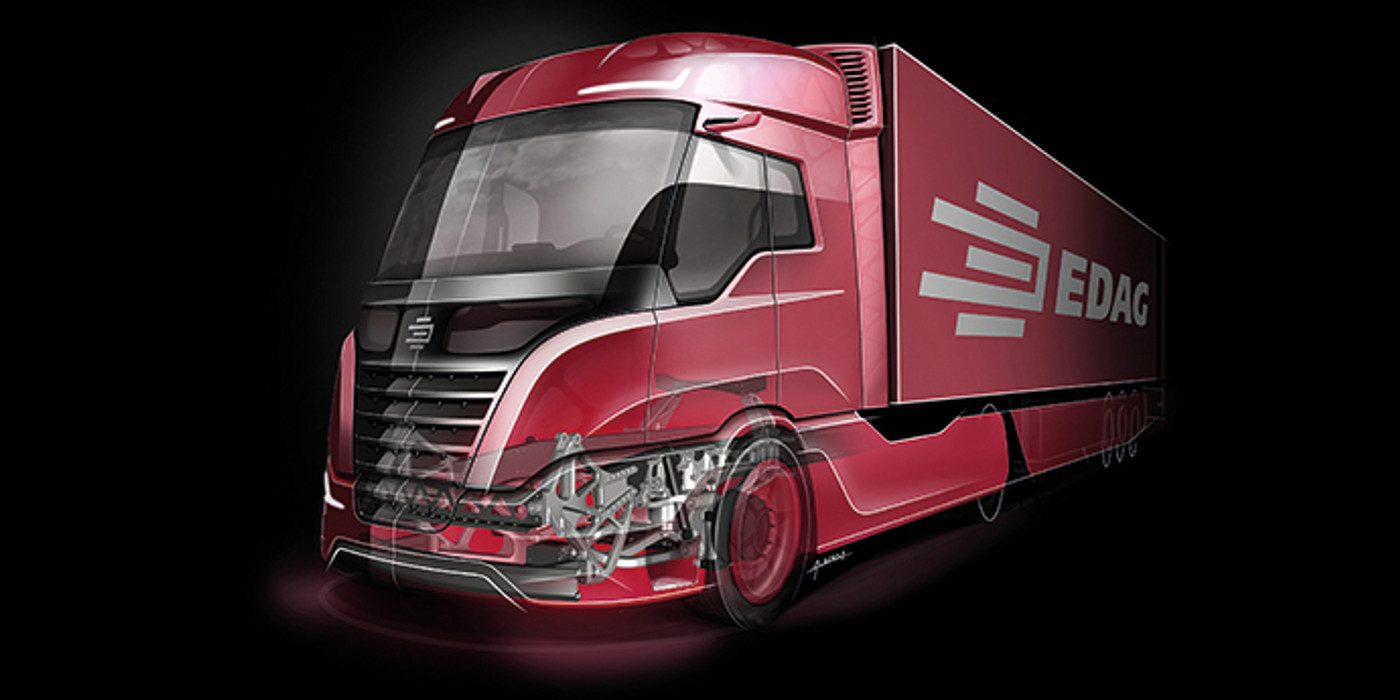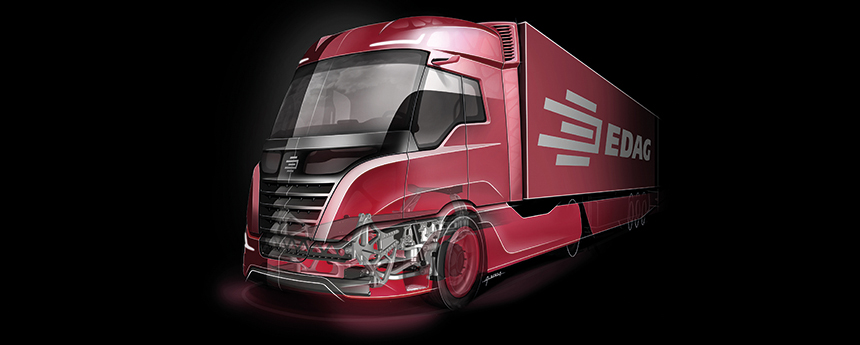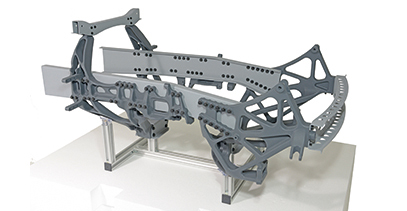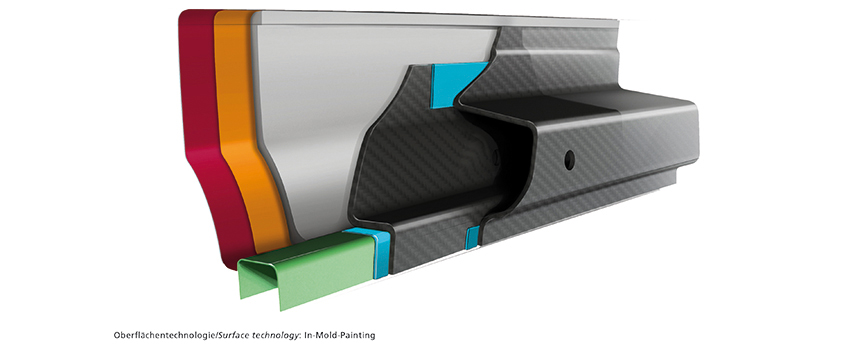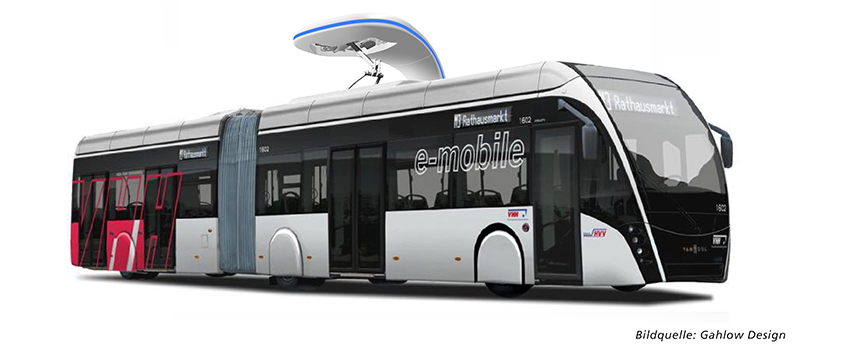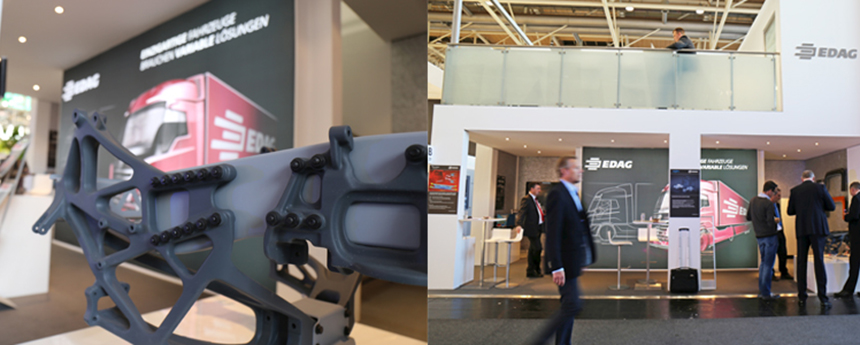The IAA for Commercial Vehicles has just opened its doors in Hanover. While the manufacturers are presenting their latest commercial vehicle, bus and transporter models, engineering specialist EDAG is offering an insight into the future of commercial vehicles, a vehicle type that, in terms of diversity and variability, is second to none. This calls for new concepts to ensure that model variety and adaptability remain both technically flexible and economically feasible in the future.
As innovative engineering specialists, EDAG produce innovative concepts to help make the commercial vehicle of tomorrow safer, lighter and, above all, to produce it more flexibly. The Wiesbaden-based engineering company is taking four concrete concepts for the future of the commercial vehicle industry to this year's IAA for Commercial Vehicles.
Down the ladder - a clever, almost weight-neutral method of independent wheel suspension integration
No-one would dispute that fact that an independent wheel suspension is safer and above all more comfortable. Nor that there might well be greater demand for this type of solution on the commercial vehicle market in the future. Even though it is possible to integrate independent wheel suspension in the currently predominant ladder type chassis frame by means of the axle bearing subframes, this is still an expensive, complicated and heavyweight solution.
When welding distortion becomes predictable
In the commercial vehicle industry, exceptions are often the rule. Individual customised solutions are standard practice, and manufacturers produce these in plants for special-purpose vehicles.
Due to the fact that batch sizes are small, welded assemblies are given preference when producing parts, as the use of expensive forged or cast parts is simply not worthwhile. Heat exposure during the welding process can bring about unwelcome effects such as distortion and internal stress, which then call for expensive and complex reworking. This is remedied by the simulation software of EDAG's technology partner Simufact.
"Simufact.welding" calculation software makes the integrated optimisation of the welding pro-cess possible. It can be used to simulate and optimise the influence of clamping devices, component design, the welding process, welding parameters and welding sequence with a view to minimising any distortion of the component. It is possible to go through dry runs of numerous process variants and then quickly judge the effect they will have on the welded component. This procedure effectively speeds up the transition from CAD component to concrete welding procedure specification.
EDAG's commercial vehicle competence centre had already presented a smart method of easily and flexibly integrating the independent wheel suspension at the IAA 2014 with its vision of a cage frame, a topologically optimised, additively manufactured commercial vehicle chassis. But from today's point of view, there is still a long way to go before structurally relevant components can be additively manufactured. Reason enough for EDAG's development specialists to take to the IAA 2016 a bridging technology solution that could be put into practice fairly soon.Their concept: large cast nodes are combined with longitudinal and cross members with rolled profiles.
Both are tried and tested technologies which can quickly be transferred into the series – the charm lies in the connection of the two systems and their load-dependent modular design. The cast nodes facilitate the simpler, more straightforward and space-saving integration of the in-dependent wheel suspension in the front end. This represents genuine added value, as there is very little space left for installation after the engine, cabin, underride guard, spring guides, cooling system and towing eyes have been positioned.
Apart from providing significantly more installation space, the new concept has another key advantage: the modular design of the cast nodes makes them so versatile that frame concepts can be flexibly and economically adapted to meet diverse needs: for long-distance transport (with independent wheel suspension), construction vehicles (with leaf springs), and the specific requirements of public transport.
The initial idea and basic concept were developed by EDAG. Our project partner, casting spe-cialists Georg Fischer Automotive AG (Schaffhausen), played an active role in the design of the large cast nodes. The overall solution was subsequently validated by means of simulation. All the typical load cases that might occur in the front end of a truck were taken into consideration for the design. With these load cases, the relevant load paths were simulated using topology optimisation, and then transferred to producible cast structures with the assistance of Georg Fischer Automotive AG. This trend setting concept demonstrates EDAG's skill in turning visions and innovations into feasible solutions.
Lightweight and stable in one: Multi-material concept for commercial vehicle body outer skin parts
Lightweight design is also a royal discipline in the field of heavy goods vehicles. After all, the important thing is to maximise the load capacity for the forwarding agent, while optimising vehicle aerodynamics and systematically applying lightweight design to reduce fuel consumption. Lightweight design in heavy goods vehicles must, however, be very cost-effective. Conventional lightweight design solutions using light alloys are often unfeasible due to the high cost of tools and materials. In the "MultiKab" research project sponsored by the German Federal Ministry of Education and Research, EDAG and its technology partners KraussMaffei Technologies, RÜHL PUROMER, IVW Kaiserslautern, Fraunhofer ICT Pfinztal, Daimler, John Deere and ADETE developed a new weight and cost-optimised multi-material system for commercial vehicle cabs.Essentially, the lightweight design concept is based on an intelligent combination of endless reinforced thermoplastics (organo sheet) and a polyurethane outer skin, with the organo sheet providing the component stiffness and hardness necessary for the structural parts. In order to be able to create the required class A surface for the outer skin components and integrate further functions if necessary, the organo sheet is polyurethane coated.
A number of different methods for creating an outer skin in visual quality were worked out. With "polyurethane flooding", the organo sheet in a tool is covered with polyurethane, a low-cost solution, as it utilises relatively simple tool technology; it does, however, necessitate a subsequent painting process.
In the second production method, this can be integrated by employing the "in-mould painting" process. This involves first of all spraying the paint and a polyurethane barrier layer into the tool. Following this, a polyurethane and glass fibre mixture is applied, the joined organo sheet load bearing structure is loaded and then pressed together. After a short curing time, the ready painted body outer skin part can be removed from the tool.
The demonstrator for the IAA 2016 shows that weight savings of up to 30 percent are possible, compared to today's standard SMC or steel monocoque design components.
Greater charging rate and range for the electric bus
For urban and local transport operators, the electric bus has long been a topic of discussion; electric buses in urban areas are, after all, almost completely silent and emission-free. The negative side of the coin is that they have a smaller drive range than conventional drive systems, and acquisition costs are higher. These two challenges have been addressed by the battery experts at BFFT, vehicle technology developers and part of the EDAG group since 2013.The BFFT specialists succeeded in extending the drive range with energy-efficient
auxiliaries (e.g. air conditioning system) and an extremely lightweight energy storage system. This helps to keep losses to a minimum, leaving more power to run the e-bus. The intelligent battery management system has a supporting effect. Throughout the driving cycle, braking energy is recovered (recuperation), to charge the battery. In addition, an innovative rapid charging system has been developed in cooperation with partners, and each terminus houses one of these, to provide the buses with new energy. A laser-assisted measuring system similar to those at tollgates for trucks detects the approaching bus. As soon as the bus has reached the prescribed charging position, a pantograph (charging arm) begins charging.
As very high energy levels must be transferred during this process, the EDAG subsidiary uses rail technology components with high charging capacities of up to 250 kW. This enables the bus to be kept running all day, until it returns to the depot in the evening for its next full recharge. At the depot, the battery is charged overnight using a DC Combo plug of the type also used in the automotive industry.
The second challenge for scheduled bus services is the question of cost. In response to this challenge, BFFT have developed a modular battery system which allows individual modules (instead of the entire system) to be changed if repairs or customer-specific adjustments are necessary. This means that it is possible for customer wishes and regional conditions to be taken into account when a battery system is being designed for a particular vehicle manufacturer. Even employees who have not been on an special high voltage safety training course can change the components. The long service life - five years or 7,000 charge cycles - cuts running costs while at the same time saving fuel and taxes, so acquisition costs can be recouped far more quickly.
